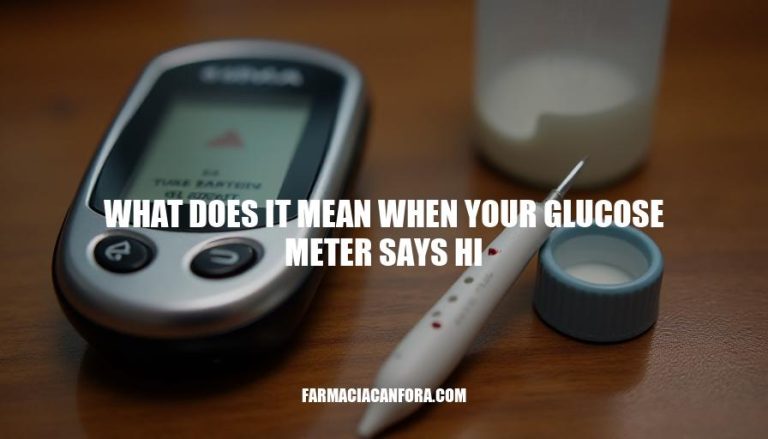


When your glucose meter displays “HI,” it means your blood glucose level is extremely high, exceeding the meter’s maximum measurable limit, often around 600 mg/dL (33.3 mmol/L). This reading indicates severe hyperglycemia, which can lead to serious complications like diabetic ketoacidosis (DKA) or hyperosmolar hyperglycemic state (HHS).
Understanding this reading is crucial for individuals with diabetes because it signals the need for immediate action, such as rechecking glucose levels, administering insulin, and seeking medical advice to prevent life-threatening conditions.
When your glucose meter displays “HI,” it means your blood glucose level is extremely high, exceeding the meter’s maximum measurable range. Most glucose meters can read blood glucose levels up to 600 mg/dL (33.3 mmol/L), though some models may have a lower maximum, such as 500 mg/dL (27.8 mmol/L) or even less.
A “HI” reading indicates severe hyperglycemia, which is a critical condition requiring immediate attention. It suggests that your blood glucose level is higher than the meter’s upper limit, which could be just above the maximum or significantly higher.
Steps to take when you see “HI”:
If your glucose meter repeatedly shows “HI,” seek medical advice immediately to manage your blood glucose levels effectively and prevent complications.
Here are the potential causes of a ‘HI’ reading on your glucose meter:
High Carbohydrate Intake: Consuming a large amount of carbohydrate-rich foods can cause a significant spike in blood glucose levels, leading to a ‘HI’ reading.
Missed Insulin Doses: Skipping or not taking enough insulin can result in elevated blood glucose levels. Insulin helps regulate blood sugar, and without it, levels can rise dramatically.
Illness or Infection: Being sick or having an infection can cause stress on the body, leading to higher blood glucose levels. The body’s response to illness often includes releasing stress hormones that can increase blood sugar.
Stress: Emotional or physical stress can trigger the release of hormones like cortisol and adrenaline, which can raise blood glucose levels.
Medications: Certain medications, especially steroids, can cause an increase in blood glucose levels.
Dehydration: Lack of sufficient fluids can concentrate the glucose in your bloodstream, leading to higher readings.
Faulty Equipment or Test Strips: Sometimes, a ‘HI’ reading can be due to a malfunctioning glucose meter or expired test strips.
Incorrect Testing Technique: Not washing hands before testing or squeezing the finger too hard to get blood can lead to inaccurate high readings.
If you get a ‘HI’ reading, it’s important to recheck your blood sugar, ensure your equipment is functioning correctly, and consult with your healthcare provider for appropriate steps to manage your blood glucose levels.
Stay safe and take care!
Here are some strategies for managing high blood glucose levels long-term:
Implementing these strategies can help you maintain stable blood glucose levels and prevent future high readings.
If your glucose meter reads “HI,” it means your blood sugar is dangerously high, typically above 600 mg/dL (33.3 mmol/L). Immediate medical help is necessary if you experience symptoms of severe hyperglycemia, such as:
These symptoms can indicate a life-threatening condition called diabetic ketoacidosis (DKA) or hyperosmolar hyperglycemic state (HHS). Seeking professional medical advice promptly is crucial to prevent serious complications. Always consult your healthcare provider for personalized guidance and treatment.
When your glucose meter displays ‘HI’, it indicates that your blood glucose level is extremely high, typically above 600 mg/dL (33.3 mmol/L). This reading signals severe hyperglycemia, which can lead to life-threatening conditions like diabetic ketoacidosis (DKA) or hyperosmolar hyperglycemic state (HHS).
It’s crucial to take immediate action by rechecking glucose levels, administering insulin, and seeking medical advice to prevent complications.
To manage high blood glucose levels effectively, focus on: